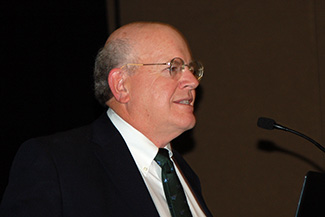Adopting Technology
Speaker encourages use of AI to make genetic and profit gains.
by Shelby Mettlen, assistant editor
The beef industry’s greatest challenge and greatest opportunity are actually one and the same, said the University of Missouri’s Dave Patterson at the National Association of Animal Breeders (NAAB) Symposium hosted May 31 as part of the Beef Improvement Federation (BIF) Symposium in Athens, Ga., May 31-June 3.
Patterson, creator of Missouri’s Show-Me-Select™ replacement heifer program, said the industry’s greatest challenge is producer reluctance to adopt new technology. Its greatest opportunity? On-the-shelf technology not being used — that works.
Take advantage of the technology
Nearly 70% of cow-calf enterprises are reported by producers as being a secondary income source. Only 10%-15% of all beef cattle enterprises utilize artificial insemination (AI). That can and should be improved, Patterson said.
“In many respects, it’s a value-added program,” Patterson said of the Show-Me-Select program. AI adds value.

The industry needs more and better reproductive data, the University of Missouri’s John Patterson said. “It all begins with heifers.”
What Patterson called “the technology problem” is well-intended. As more research is conducted, more advanced technology results, leading to greater complexity and sophistication. Fewer people understand it, fewer people trust it, and progress is slowed, he said.
In 1996, Patterson created the Show-Me-Select program to create an understanding of the importance of heifer development based on reproductive outcomes. Since the program’s inauguration, nearly 130,000 heifers have been enrolled in the program. Only 32,381 of those have been sold — primarily because the animals are being held as replacements.
The program draws on the fundamentals that founded Extension and land-grant systems: It works to transfer science-based knowledge that enables participants to make practical production and management decisions based on economics.
Two of the most notable outcomes of the program are the expanded uses of fixed-time AI (FTAI) and ultrasound for performing pregnancy checks.
The discussion raises the question: Can producers make more money by adopting these technologies? The short answer, said Patterson, is “yes.”
Research results from the program between 2010 and 2016 illustrate that the use of AI consistently added value over natural-service breeding, with premiums surpassing $400 compared to heifers bred by natural service.
Looking ahead, animal scientists, including reproductive physiologists and geneticists, need to work more closely with veterinarians and the AI industry, Patterson pointed out. The industry needs more and better reproductive data, and “it all begins with heifers,” he said.
Editor’s Note: This summary was written under contract or by staff of Angus Media. Through an agreement with the Beef Improvement Federation, we are encouraging reprinting of the articles to those who will adhere to the reprint guidelines available on this site. Please review those guidelines or contact Shauna Rose Hermel, editor, at 816-383-5270. PowerPoints are posted with permission of the presenter and may not be reproduced in whole or in part without the express permission of the presenter.
Angus Media’s coverage of the event is made possible through collaboration with BIF. For questions about this site, or to notify us of broken links, click here. Look for additional coverage in the Angus Journal, the Angus Beef Bulletin, the Angus Journal Daily, the Angus Beef Bulletin EXTRA and Angus TV.


